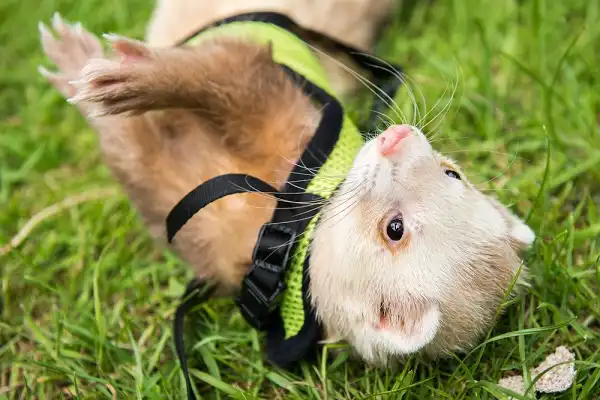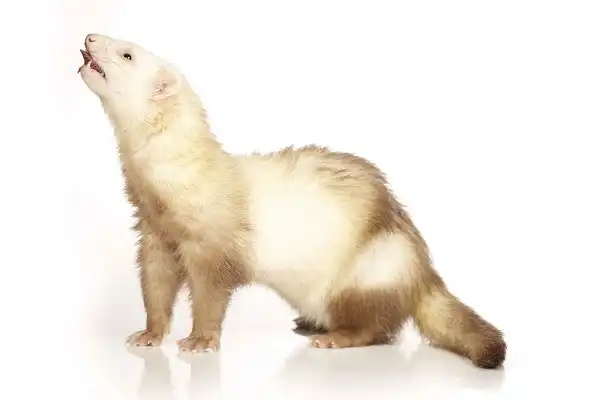Have you ever heard of a cinnamon ferret? If not, don’t worry because this surprisingly adorable creature is about to become your new favorite obsession! Not only are they so stinkin’ cute that it will be hard to take your eyes off them, but they also make excellent companions. That’s right – these cuddly creatures are capable of becoming wonderful additions to the family and require much less upkeep than other furry friends. Whether you’re looking for a pocket-sized pal or just want something different from the standard pet options, a cinnamon ferret might be exactly what you’ve been searching for!

Cinnamon Ferret Description
Cinnamon ferrets are a delightful variety of domesticated ferrets that stand out due to their unique coat color. Their fur, as their name suggests, is a warm, cinnamon-like hue that distinguishes them from other ferret varieties. They typically have a white or cream undercoat and a golden-brown topcoat, which results in their beautiful, warm-toned fur. This coloration may vary from ferret to ferret, but the overall tone remains the same: a lovely blend of gold, brown, and red. These ferrets are known for their agility and active nature. They are adept climbers and diggers, possessing an inquisitive and playful disposition that keeps their owners entertained. Cinnamon ferrets have rounded, glossy eyes that range from black to light brown, contributing to their expressive and adorable appearance. Their ears are large and stand erect, which is often a sign of alertness and curiosity.
Cinnamon Ferret Habitat
Cinnamon ferrets, like all domestic ferrets, thrive in a spacious and stimulating environment. They are very active creatures and require plenty of space to explore, play, and exercise. A large cage or an enclosed area within your home would serve as an ideal habitat for a cinnamon ferret. The cage or area should have smooth sides to prevent escape and minimize the risk of injury. It should also contain multiple levels for them to climb and explore, as ferrets love vertical spaces. The bedding should be soft and comfortable, preferably made of washable fabric, to provide them with a cozy sleeping spot. Environmental enrichment is vital for the well-being of cinnamon ferrets. Apart from regular out-of-cage playtime, their habitats should contain a variety of toys, tunnels, and hideaway spots to keep them mentally stimulated and entertained. Ferrets are known for their playful nature and love of exploration, hence, interactive toys, puzzle feeders, and other such items can significantly enhance their living space. Proper ventilation is crucial to avoid the buildup of odors and to maintain a healthy living condition. It’s also important to keep their living area clean by regularly removing waste and washing the bedding.
Cinnamon Ferret Diet
Like their relatives, cinnamon ferrets are obligate carnivores, which means their diet primarily consists of meats. They require a high protein, high fat, and low fiber diet to stay healthy and active. Commercially prepared dry ferret food meets these requirements and is often a staple in their diet. However, it’s crucial to ensure the food is high-quality and specifically designed for ferrets, as cat and dog food does not provide the necessary nutritional balance they need. While dry food forms the core of their diet, cinnamon ferrets can also consume raw or cooked meat like chicken, turkey, or beef. Raw meat closely resembles their natural diet in the wild and can be a healthy addition to their meal plan. It’s worth noting, however, that any changes to their diet should be introduced gradually to prevent digestive issues. Raw eggs can also be given as a treat, providing additional nutrients. Always remember to remove uneaten food to prevent spoilage. Alongside their carnivorous diet, hydration is vital for cinnamon ferrets. Always ensure they have access to fresh and clean water to keep them hydrated. Unlike some other pets, ferrets do not generally consume large quantities of water with their meals, so they must have water available at all times.

Cinnamon Ferret Size
As previously mentioned, cinnamon ferrets are on par with other ferret breeds in terms of size. On average, they measure from 18 to 24 inches in length from nose to tail tip when fully grown. This measurement includes their body and tail, which make up approximately two-thirds and one-third of their total length, respectively. Their relatively elongated body structure contributes to their agility and quick movements, which is a characteristic feature of all ferrets. Male cinnamon ferrets usually have more robust bodies compared to their female counterparts. They weigh between 2 to 3.5 pounds, whereas females typically weigh between 1 to 2.5 pounds. This notable size difference between males and females is commonly referred to as sexual dimorphism, and it’s a common trait in many animal species. Despite their small size, cinnamon ferrets possess high levels of energy and are very active, making them an entertaining pet to have around.
Cinnamon Ferret Lifespan
Cinnamon ferrets, like all domestic ferrets, have an average lifespan ranging from 7 to 10 years under optimal care. However, individual lifespan can vary based on a variety of factors, including genetics, diet, environmental conditions, and overall health status. It is not uncommon for some ferrets to reach the age of 12 or even older, especially when they are provided with the necessary care, a balanced diet, and preventative medical check-ups. Regular visits to a veterinarian experienced with ferrets can aid in the early detection of health issues, potentially extending their lifespan. The first few years of a cinnamon ferret’s life are characterized by high energy levels and robust health. However, as they advance into middle age (around 4 to 5 years), they may start to show signs of aging such as reduced activity levels, changes in eating habits, or specific age-related health issues. Common health problems among aging cinnamon ferrets include adrenal disease, insulinoma, and various forms of cancer. Early detection and effective management of these conditions can significantly improve their quality of life and potentially extend their lifespan.
Cinnamon Ferret Behavior
Cinnamon ferrets are known for their playful and curious nature, making them entertaining pets to have around. They possess an inherent zest for exploration and are quite active during their waking hours. These animals are crepuscular, meaning they are most active during dawn and dusk. However, they also adjust their schedules based on their owners’ routines. They love engaging in activities that stimulate their minds, such as tunneling through pipes or playing with toys. Moreover, they are quite fond of hoarding objects, so don’t be surprised if you find your belongings stashed in their favorite hiding spots. In terms of social behavior, cinnamon ferrets are quite interactive and thrive on companionship. They enjoy the company of their human families and are known to form strong bonds with their owners. Furthermore, they get along well with other ferrets, often engaging in playful wrestling and chase games. They communicate using a variety of vocalizations, body language, and scent markings. While they are generally friendly animals, it is crucial to handle them with care and respect to avoid any potential nipping or scratching.

Cinnamon Ferret Speed
Cinnamon ferrets are renowned for their agility and rapid movements. Their relatively long bodies and short legs, coupled with their muscular build, allow them to move swiftly and nimbly across a variety of terrains. They are capable of reaching speeds of up to 15 mph under certain circumstances, demonstrating their impressive physical capabilities. This speed is particularly useful when they are engaged in their natural playful behavior, such as chasing toys or participating in playful wrestling with other ferrets. However, it’s important to note that the speed of a cinnamon ferret can also be influenced by various factors including age, health, and level of physical fitness. Young, healthy ferrets are likely to be faster and more agile than older or less active individuals. Regular physical activity and play can help maintain a cinnamon ferret’s speed and agility, contributing to its overall well-being and quality of life.
Cinnamon Ferret Reproduction
Cinnamon ferrets, like other ferrets, are seasonal breeders. Their breeding season typically occurs from December to August, with the peak being in March and April. Female ferrets, known as jills, come into heat in the spring and will stay in heat until they mate. Failure to mate can lead to serious health issues due to prolonged elevated estrogen levels, such as aplastic anemia. Therefore, it is generally recommended that pet ferrets be spayed if they are not intended for breeding. The gestation period for a ferret is approximately 42 days. A litter may comprise 1 to 8 kits, with an average of 4 to 6. The kits are born blind, deaf, and almost hairless, weighing between 6 to 14 grams. The mother is responsible for their care and will nurse the kits for 3 to 6 weeks before they are weaned. At around 5 weeks, the kits start to open their eyes and their teeth begin to emerge. By 8 weeks, they are usually fully weaned and ready to start eating solid food. As the kits mature, they begin to exhibit the playful and curious behavior typical of ferrets. At around 3 months, they reach sexual maturity. However, it is advisable to wait until the ferrets are older before breeding them.
Cinnamon Ferret Hunting
In the wild, cinnamon ferrets are proficient hunters, harnessing their agility, speed, and keen senses to catch prey. Similar to other ferret types, they have a natural predilection towards burrowing animals, including rabbits and rodents. Their slender bodies and sharp claws allow them to delve into burrows and chase their prey with precision. Equipped with sharp, carnivorous teeth, they are capable of delivering a lethal bite to their targets. Despite their domestication, pet cinnamon ferrets often retain these natural hunting instincts. They exhibit behaviors such as stalking, pouncing, and shaking toys, which mimic the actions of hunting and killing prey in the wild. Owners can utilize this instinctive behavior to engage their ferrets in interactive play, using toys that mimic the movement and appearance of small animals. This not only provides mental stimulation for the ferret but also helps to keep them physically active and healthy. However, it’s essential for owners to remember that the hunting instincts of ferrets can pose a risk to other small pets in the household, such as birds, rodents, or reptiles. Therefore, it is advisable to keep them separated or supervised when interactions occur.

Conclusion
In conclusion, cinnamon ferrets are a unique and fascinating breed of ferrets. Their distinctive coat color, agility, and hunting instincts make them a joy to observe and interact with. They require attentive care, including the provision of a safe environment that caters to both their active and restful periods, as well as careful consideration of their reproductive needs. Although they retain their instinctual hunting behavior, they can still be sociable and loving companions with the right training and socialization. Their playful and curious nature, coupled with their physical prowess, makes them a truly distinctive addition to the animal kingdom and a delightful pet for those who appreciate their unique characteristics.
Frequently Asked Question


